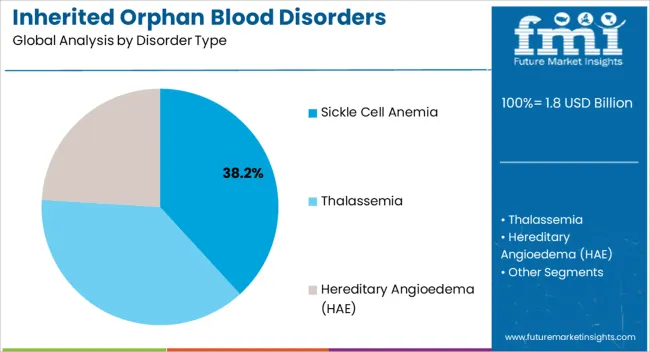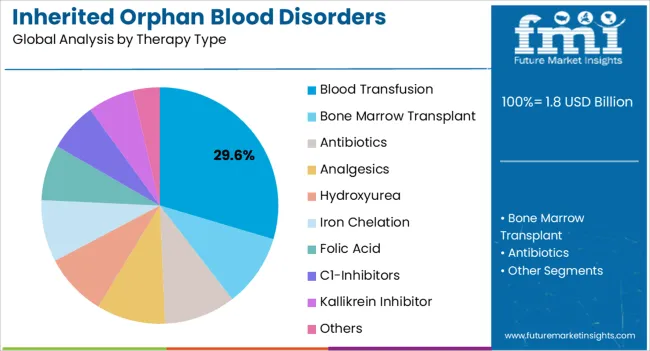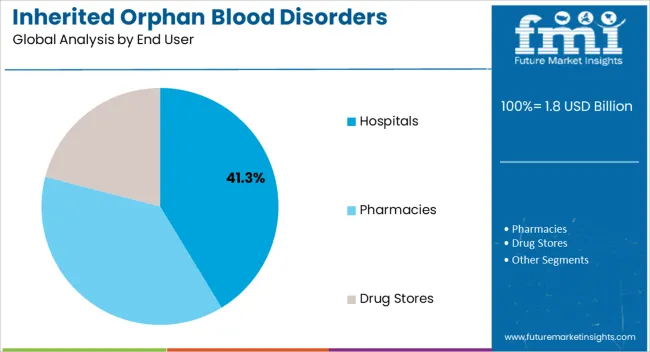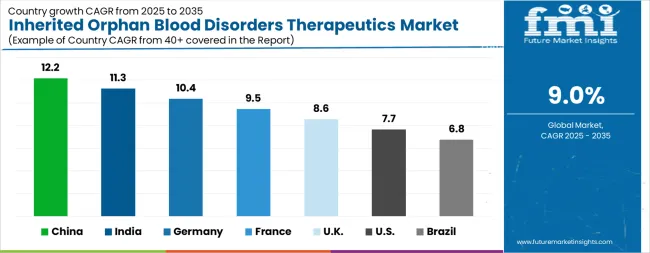The Inherited Orphan Blood Disorders Therapeutics Market is estimated to be valued at USD 1.8 billion in 2025 and is projected to reach USD 4.2 billion by 2035, registering a compound annual growth rate (CAGR) of 9.0% over the forecast period.
| Metric | Value |
|---|---|
| Inherited Orphan Blood Disorders Therapeutics Market Estimated Value in (2025 E) | USD 1.8 billion |
| Inherited Orphan Blood Disorders Therapeutics Market Forecast Value in (2035 F) | USD 4.2 billion |
| Forecast CAGR (2025 to 2035) | 9.0% |
The Inherited Orphan Blood Disorders Therapeutics market is experiencing steady growth, driven by the increasing prevalence of rare genetic blood disorders and rising awareness of treatment options. Growth is supported by the ongoing development of specialized therapies, improvements in diagnostic capabilities, and early detection programs. Blood disorders such as sickle cell anemia and thalassemia impose significant health burdens, which has led to increased focus on patient-centric therapeutic solutions.
Hospitals, specialized clinics, and research institutions are investing in advanced treatment modalities to improve patient outcomes and reduce complications associated with chronic blood disorders. The market is further bolstered by regulatory support, orphan drug incentives, and public-private collaborations that accelerate research and commercialization of novel therapies.
Technological advancements, including gene therapy, molecular medicine, and improved blood transfusion protocols, are enabling more effective and safer treatment options As healthcare systems prioritize rare disease management and patient access to innovative therapeutics, the market is expected to maintain sustainable growth, with opportunities emerging from expanded access programs and increasing global awareness of inherited blood disorders.
The inherited orphan blood disorders therapeutics market is segmented by disorder type, therapy type, end user, and geographic regions. By disorder type, inherited orphan blood disorders therapeutics market is divided into Sickle Cell Anemia, Thalassemia, and Hereditary Angioedema (HAE). In terms of therapy type, inherited orphan blood disorders therapeutics market is classified into Blood Transfusion, Bone Marrow Transplant, Antibiotics, Analgesics, Hydroxyurea, Iron Chelation, Folic Acid, C1-Inhibitors, Kallikrein Inhibitor, and Others. Based on end user, inherited orphan blood disorders therapeutics market is segmented into Hospitals, Pharmacies, and Drug Stores. Regionally, the inherited orphan blood disorders therapeutics industry is classified into North America, Latin America, Western Europe, Eastern Europe, Balkan & Baltic Countries, Russia & Belarus, Central Asia, East Asia, South Asia & Pacific, and the Middle East & Africa.

The sickle cell anemia segment is projected to hold 38.2% of the market revenue in 2025, establishing it as the leading disorder type. Growth in this segment is driven by the high global prevalence of sickle cell anemia and the increasing need for effective management of its associated complications. Chronic pain, organ damage, and frequent hospitalizations associated with the disorder have increased demand for targeted therapeutics.
Innovative treatment options, including gene therapies and pharmacological interventions, are enhancing patient outcomes and improving quality of life. Hospitals and specialized care centers are prioritizing comprehensive treatment strategies that combine blood transfusions, supportive care, and emerging therapeutics.
Awareness campaigns, patient education programs, and genetic screening initiatives are further contributing to adoption As healthcare providers seek cost-effective and scalable solutions to manage sickle cell anemia, the disorder type segment is expected to maintain its leading market position, supported by ongoing research, clinical advancements, and increasing investments in rare disease therapeutics.

The blood transfusion therapy segment is anticipated to account for 29.6% of the market revenue in 2025, making it the leading therapy type. Its growth is driven by the need to manage severe anemia, prevent complications, and improve patient survival in inherited blood disorders. Blood transfusions are widely used due to their immediate efficacy in increasing hemoglobin levels and reducing clinical complications.
The segment benefits from technological advancements in blood screening, storage, and delivery, which enhance safety and reliability. Hospitals and specialized treatment centers increasingly adopt standardized transfusion protocols, ensuring better outcomes and minimizing adverse reactions.
Ongoing research into optimized transfusion strategies, coupled with supportive policies and guidelines, is further strengthening adoption As healthcare systems focus on improving accessibility and safety of transfusion services, the blood transfusion therapy segment is expected to retain its leading position, supported by rising patient populations, increasing hospital-based treatments, and integration with complementary therapies such as iron chelation and gene therapy.

The hospitals end user segment is projected to hold 41.3% of the market revenue in 2025, establishing it as the leading end-use category. Hospitals remain central to the management of inherited orphan blood disorders due to their capacity to provide comprehensive care, including diagnostics, transfusion services, and therapeutic interventions. Growth in this segment is supported by the increasing prevalence of complex blood disorders and the demand for multidisciplinary care teams that can manage chronic conditions effectively.
Hospitals are investing in infrastructure, specialized equipment, and trained personnel to deliver advanced therapies safely. Clinical monitoring, patient management, and emergency care capabilities further enhance their role as the primary end user.
Rising awareness, government support for rare disease treatment, and increasing patient referrals are contributing to adoption As integrated care models and specialized treatment programs expand globally, hospitals are expected to continue dominating the market, providing scalable and efficient solutions for the growing patient population and reinforcing their position as the largest end-use segment.
Blood disorders are mainly affect the one or more parts of the blood and prevent blood from doing its basic functions in the body. Blood disorders may be acute or chronic based on the cause and part of the blood system affected. Many blood disorders are inherited and some are acquired over the course of lifetime in a human being.
Orphan diseases are those diseases which affect the fewer than 200,000 people which has been not adopted by the pharmaceutical companies owing to little financial incentives for discovery or marketing. There are several blood disorders which are considered orphan owing to lesser prevalence.
Inherited blood disorders are seen due to genetic abnormalities in the patient population. Inherited orphan blood disorders includes sickle cell anaemia, thalassemia, and Hereditary Angioedema (HAE) which are less prevalent. There are very few therapeutic options available for addressing inherited orphan blood disorders.

| Country | CAGR |
|---|---|
| China | 12.2% |
| India | 11.3% |
| Germany | 10.4% |
| France | 9.5% |
| UK | 8.6% |
| USA | 7.7% |
| Brazil | 6.8% |
The Inherited Orphan Blood Disorders Therapeutics Market is expected to register a CAGR of 9.0% during the forecast period, exhibiting varied country level momentum. China leads with the highest CAGR of 12.2%, followed by India at 11.3%. Developed markets such as Germany, France, and the UK continue to expand steadily, while the USA is likely to grow at consistent rates. Brazil posts the lowest CAGR at 6.8%, yet still underscores a broadly positive trajectory for the global Inherited Orphan Blood Disorders Therapeutics Market. In 2024, Germany held a dominant revenue in the Western Europe market and is expected to grow with a CAGR of 10.4%. The USA Inherited Orphan Blood Disorders Therapeutics Market is estimated to be valued at USD 611.9 million in 2025 and is anticipated to reach a valuation of USD 1.3 billion by 2035. Sales are projected to rise at a CAGR of 7.7% over the forecast period between 2025 and 2035. While Japan and South Korea markets are estimated to be valued at USD 87.5 million and USD 52.3 million respectively in 2025.
| Item | Value |
|---|---|
| Quantitative Units | USD 1.8 Billion |
| Disorder Type | Sickle Cell Anemia, Thalassemia, and Hereditary Angioedema (HAE) |
| Therapy Type | Blood Transfusion, Bone Marrow Transplant, Antibiotics, Analgesics, Hydroxyurea, Iron Chelation, Folic Acid, C1-Inhibitors, Kallikrein Inhibitor, and Others |
| End User | Hospitals, Pharmacies, and Drug Stores |
| Regions Covered | North America, Europe, Asia-Pacific, Latin America, Middle East & Africa |
| Country Covered | United States, Canada, Germany, France, United Kingdom, China, Japan, India, Brazil, South Africa |
| Key Companies Profiled | Biogen Idec, Gamida Cell, Anthera Pharmaceuticals, Alnylam Pharmaceuticals, Sangamo BioSciences, Global Blood Therapeutics, Mast Therapeutics, and Genetix Pharmaceuticals Inc |
The global inherited orphan blood disorders therapeutics market is estimated to be valued at USD 1.8 billion in 2025.
The market size for the inherited orphan blood disorders therapeutics market is projected to reach USD 4.2 billion by 2035.
The inherited orphan blood disorders therapeutics market is expected to grow at a 9.0% CAGR between 2025 and 2035.
The key product types in inherited orphan blood disorders therapeutics market are sickle cell anemia, thalassemia and hereditary angioedema (hae).
In terms of therapy type, blood transfusion segment to command 29.6% share in the inherited orphan blood disorders therapeutics market in 2025.






Full Research Suite comprises of:
Market outlook & trends analysis
Interviews & case studies
Strategic recommendations
Vendor profiles & capabilities analysis
5-year forecasts
8 regions and 60+ country-level data splits
Market segment data splits
12 months of continuous data updates
DELIVERED AS:
PDF EXCEL ONLINE
Inherited Retinal Diseases Treatment Market Size and Share Forecast Outlook 2025 to 2035
Orphan Drugs Market Size and Share Forecast Outlook 2025 to 2035
Biotherapeutics Virus Removal Filters Market Trends – Growth & Forecast 2025 to 2035
COPD Therapeutics Market Report – Growth, Demand & Industry Forecast 2023-2033
Digital Therapeutics and Wellness Market Size and Share Forecast Outlook 2025 to 2035
Digital Therapeutics Market Size and Share Forecast Outlook 2025 to 2035
Peptide Therapeutics Market Analysis - Growth & Forecast 2024 to 2034
Advanced Therapeutics Pharmaceutical Outsourcing Market Size and Share Forecast Outlook 2025 to 2035
Glaucoma Therapeutics Market Size and Share Forecast Outlook 2025 to 2035
Leukemia Therapeutics Treatment Market Analysis - Growth & Forecast 2025 to 2035
Microbiome Therapeutics Market Size and Share Forecast Outlook 2025 to 2035
The Canine Flu Therapeutics Market is segmented by product, and end user from 2025 to 2035
Stuttering Therapeutics Market Trends, Analysis & Forecast by Treatment, Type, End-Use and Region through 2035
Pet Cancer Therapeutics Market Insights - Growth & Forecast 2024 to 2034
Candidiasis Therapeutics Market Size and Share Forecast Outlook 2025 to 2035
Lung Cancer Therapeutics Market Analysis – Size, Share, and Forecast Outlook 2025 to 2035
Heart Block Therapeutics Market Size and Share Forecast Outlook 2025 to 2035
Aquaculture Therapeutics Market Size and Share Forecast Outlook 2025 to 2035
Fucosidosis Therapeutics Market - Growth & Innovations 2025 to 2035
Market Leaders & Share in Alzheimer’s Therapeutics

Thank you!
You will receive an email from our Business Development Manager. Please be sure to check your SPAM/JUNK folder too.
Chat With
MaRIA